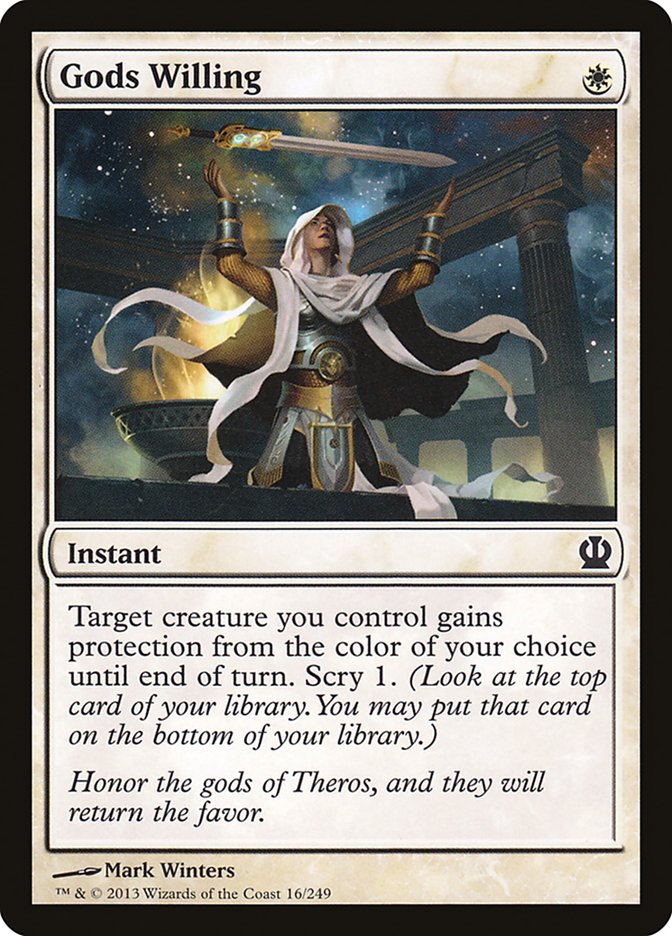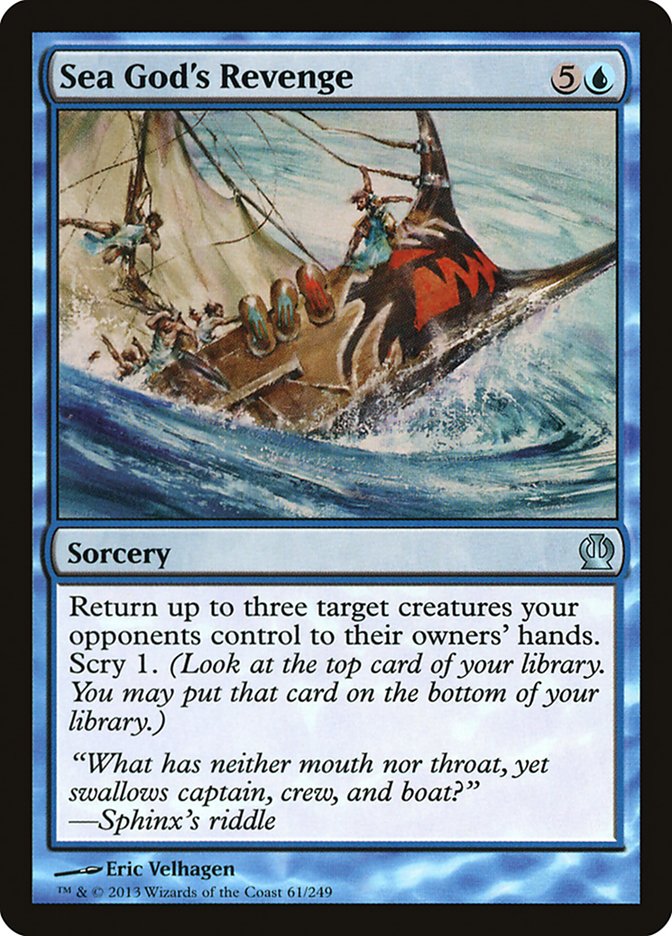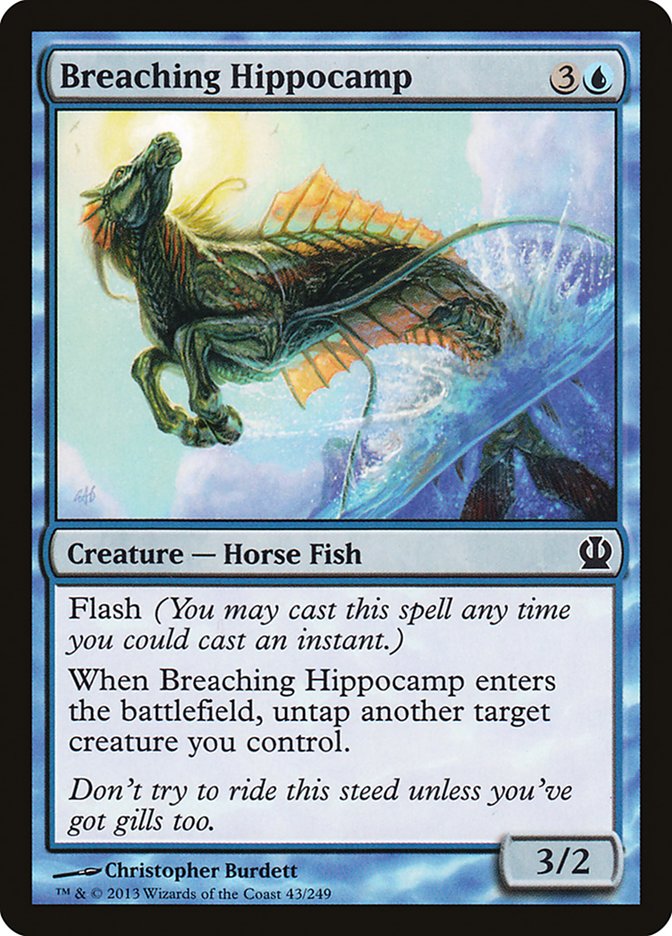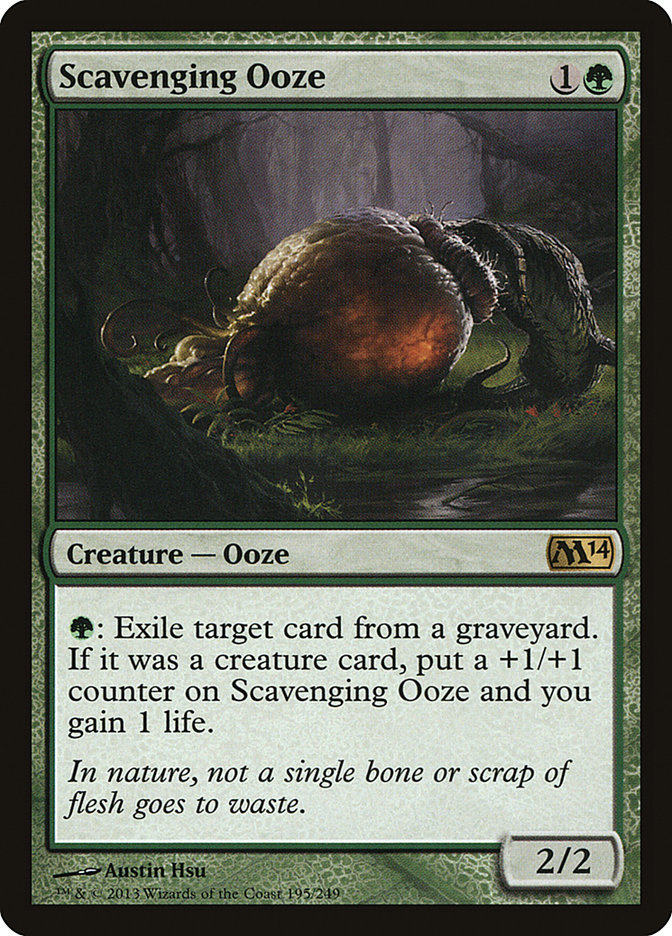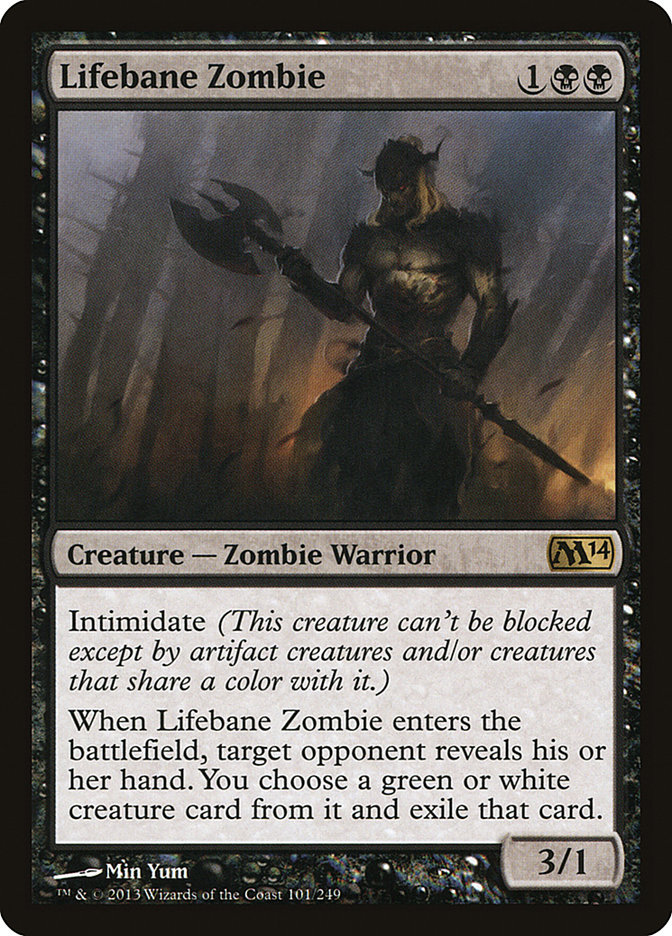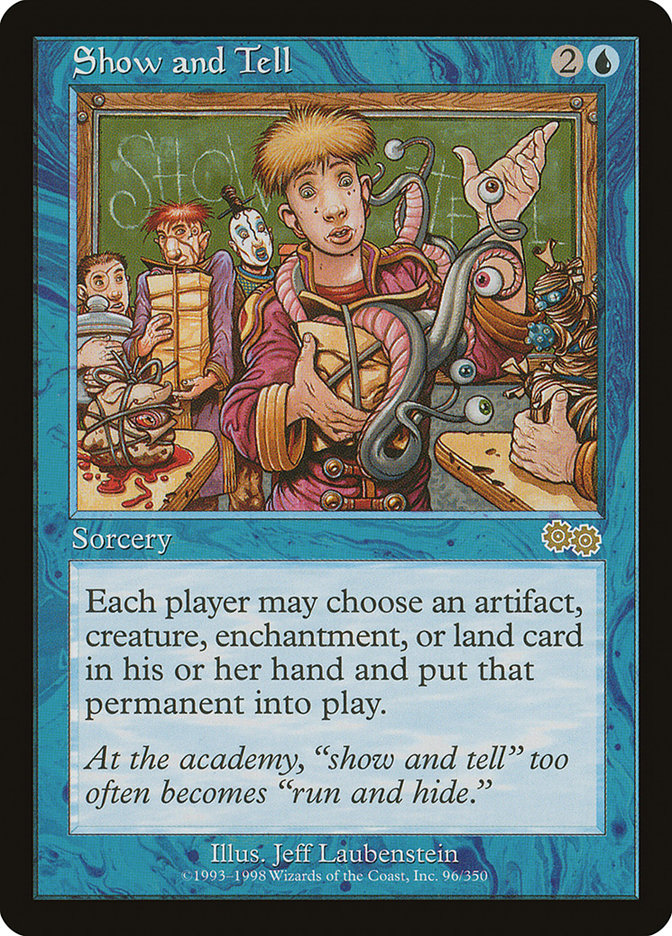I have a lot of thoughts that I want to get out there, but some aren’t worthy of their own entire article. I want to get them all out there in a timely manner, so here is a bit of a gumbo piece. I have some rants on the design of Theros, some notes on Standard moving forward (with a decklist), and a word on Show and Tell in Legacy.
But let’s start with design. There are a couple of things that I really don’t like about the new set. Theros is awesome overall—don’t get me wrong. There are some individual designs that I like a lot, and the overall flavor of the set has been very well executed. Some of the top-down designs are fantastic. Cards like Chained to the Rocks, Akroan Horse, and Underworld Cerberus to name three of my favorites. (I also quite like the jab of Traveling Philosopher having zero abilities.) This set feels like what Champions of Kamigawa should have been, and it makes me hope they do more planes like this in the future.
I think there are some design and development decisions that are worth considering and others that I believe are fairly inexcusable mistakes and want to discuss them here as well as get your thoughts and opinions.
The most outstanding thing to me in the set—and not in a good way—is the seemingly random inclusion of the ability scry. Now, I think scry is an excellent mechanic in its own right and deserves more use and exploration in design space. However, I think that Theros was an extremely poor place to put it. I asked renowned professional game designer and all-around nut-high human Patrick Sullivan for his thoughts before sharing mine, and he said everything I was going to better than I could have. That type of confirmation is reassuring and validating.
For starters, it feels entirely tacked on. It’s hard to explain, but it feels strongly as if the set was well into its design before someone at R&D suggested scry and then they put it in. It doesn’t make much sense on many of the cards that have it and isn’t a very coherent and flavorful part of the set as a whole. More realistically, what probably happened was that Development wanted dual lands for Standard with the “buddy lands” rotating, they came up with the Temples or “scry lands,” and then they thought “why just those?” and put scry on a bunch of things.
Save the strange inclusion of Flamespeaker Adept, scry’s role in Theros is to be put onto a bunch of otherwise fine if perhaps slightly overcosted cards to give them a little extra value. A lot of the cards that scry are things like removal spells and giant powerful creatures. Why? The point of scry is to smooth out your draws and mana base in the early turns and then find high-impact cards later on. So why tack scry 1 onto a huge effect like Sea God’s Revenge? That’s a card you should be scrying to, not scrying with. It feels so underwhelming on the backside of this explosive play that it actually robs the card of a lot of its feeling. “Bounce your team, and now prepare for my massive alpha strike!!! Wait. Hold on. I have to look at the top card of my deck for a second.”
And the other side of it is not exactly feel-good city either, almost like they’re rubbing it in. “It’s not enough that I have to respend all of this time and mana; you have to let me know you’re drawing a spell next turn too?”
Things like Rage of Purphoros get the worst of both sides of the anti-scry argument, as it is a removal spell (something you’re generally trying to find, not find something with) but also something that is fairly slow and inefficient (as compared to the hyperefficient creatures in the set—especially considering monstrous and bestow) that is somewhat justified being so pricey because of this tacked-on, unflavorful, marginal extra value.
Finally, my last—and likely strongest—argument against the decision to put scry into Theros is how much it overlaps with two of the three of the set’s mechanics: monstrous and bestow.
Generally speaking, there are two types of abilities in Magic: ones that reduce variance and ones that snowball. I have an article in the works about snowballing mechanics and a theory that will actually be an update/part two of an older article. The best examples of the other type are things like kicker and cycling, two of the most beloved abilities of all time (at least by competitive players). Heroic is a snowbally mechanic. However, monstrosity and bestow are closer to the variance-reducing end of the spectrum. If you have a card early, then you cast it normally, and it’s fine. And if you draw it later, then you can use its ability, and it becomes a powerful mana sink if you’re flooded or in a topdecking endgame.
Besides being good to draw at different points in the game, these abilities are also powerful because they make all of your other draws live. If you have a creature with monstrosity out or one with bestow in your hand, you don’t mind drawing a land because it’s that much closer to going large, but you also don’t mind drawing a spell because then you have a spell to cast. This is the strength of having mana sinks.
However, scry is an ability that flies in the face of exactly this principle. If you’re happy with any draw, then what good is scry to you? And with two of the three major abilities of the set pulling in that direction—rewarding conservative deckbuilding and high land counts—why add an ability that overlaps so heavily with what the mana sinks are trying to do? Now you have the abilities in your set actively contradicting each other when they should be playing well together. Think of all of the other sets where the Limited environment could’ve greatly used some card selection and draw smoothing. Why now to bring back scry?
I lied. I have one more gripe with scry, though this is non-Theros specific and I’m not even sure it has a good solution, and that is the constant touching of one’s deck. While I think scry lands are sweet designs and very good for competitive play, it does worry me a little simply because it is so easy to cheat with them and hard to catch those that do. Something as small as when you scry to the bottom to glance at your bottom card as you put it there. That information can be very valuable and something you shouldn’t have access to. And that’s just the softer side of things as opposed to blatantly drawing an extra card under the guise of Scrying or quickly playing a Watery Grave into a pile of Temple of Deceits and taking a looky-loo and more.
I’m just a bit wary of such things and am disconcerted by these cards. Like I said, I don’t think it’s a huge deal or even one with a reasonable solution other than to watch your opponents carefully. It’s just something that I wanted to mention and make the public more aware of in an attempt to stamp out any would-be cheats.
I’ve already discussed my thoughts on the design of Hero’s Downfall in my article hereon Hammer of Purphoros. I also praise the design of the Hammer itself.
As far as individual card designs/inclusions, the most egregious error has to be the fish crab himself, Breaching Hippocamp. This is a card that plays exactly like a combat trick and targets your own creature yet doesn’t trigger heroic. This type of non-intuitive, rules-technical interaction is something to avoid as a game designer. Especially at common. Imagine a newer player opening this in a draft, excitedly taking it for his Heroic deck, and being disappointed to find it doesn’t work. That’s not the type of experience you want a player to have.
It’s not an important card or even one that is all that interesting and easily could have been replaced or changed. Lesser offenders of a similar principle are things like Leonin Snarecaster that could easily have “an opponent controls” tagged on the end of its single line of rules text to avoid any confusion. Breaching Hippocamp is on another level though since it does play so much like a spell.
My last complaint about Theros design is Triton Tactics. Why on earth does this card have so much freaking text? It’s like a novel on a one-mana instant. The card doesn’t even make any sense! What sort of tactics are being employed here exactly? Who knows! But it’s a super annoying combat trick that doubles as a super-charged heroic enabler. Isn’t that enough? Any one of its many abilities could easily be removed and the card overall would hardly be impacted whatsoever, yet it would be a much cleaner design.
Alright, enough design talk. On to Standard talk.
I have said before that my metagame forecast was something like Mono-Blue Devotion from the Pro Tour to Esper Control to R/G Devotion (which kind of got skipped) to Mono-Black Devotion and the question was going to be what comes next. We’ve reached that point in time. Esper Control will still exist since it has game against Mono-Black Devotion and the field.*
Then the projections become a bit murkier. Red decks seem to be decently positioned in this theoretical metagame but are highly volatile and underrepresented, not to mention unstreamlined. The three-color midrange decks and all of the G/W Aggro and Midrange builds are lacking the necessary tools to compete in the metagame as it stands, and no other lower tier archetypes are stepping forward and setting themselves apart from the pack in any discernible manner. So where do we go from here?
*The thing about Esper Control is that its good matchups are quite good while its bad matchups are just slightly unfavorable coin flips, whereas other decks have insane matchups and nigh unwinnable matchups. This is why Esper will continue to prevail. This in addition to the fact that I believe it simply has more good matchups than some of the other major players.
Maybe Esper evolves to combat Mono-Black by playing Ratchet Bombs like U/W Control or more Blood Baron of Vizkopas ala William Jensen Invitational list. In the short term, I think that we’re going to see a continuation of Mono-Black Devotion’s domination (though that may be a bit of a heavy word choice) as we see the lists evolve to be more incestuous. Erebos main, a removal package more weighted toward the mirror, and so on. The biggest evolution will likely come in the form of a wider acceptance of a splash.
I’ve been trashing the B/G Devotion decks since first seeing the lists from the Pro Tour—but with good reason. Willy Edel was championing a version of it:
Creatures (18)
- 4 Scavenging Ooze
- 4 Desecration Demon
- 4 Lifebane Zombie
- 3 Gray Merchant of Asphodel
- 3 Reaper of the Wilds
Lands (26)
Spells (16)

This is just a crappy midrange deck. The reason to play these decks is Underworld Connections. Read the Bones is no substitute, and the mana is so bad that it can’t support the Phyrexian Arena. Other number discrepancies aside (three Thoughtseizes—really?) the deck is just a ball full of mediocrity. Scavenging Oozes are that rare combination of unimpressive and rough on the mana. I could go on, but I won’t. It was a fine deck for that tournament, and that was very early in the life of the format.
However, I continued to trash on B/G a fair amount, saying that it was simply worse than Mono-Black Devotion. And I stand by that. It continued to be a crappy midrange deck with poor mana and lacking a true engine. Meanwhile, Mono-Black just played Thoughtseize into Underworld Connections and continued to win game after game. Finally, people wised up and started packing the Mono-Black engine into their B/G decks, but it still wasn’t quite there yet. The reasons for this were two-fold:
1. The incentive to be splashing green wasn’t strong enough yet.
2. The builds were still underdeveloped.
What I mean by the latter is that a lot of the card choices were poor. Reaper of the Wilds is not a good Magic card and doesn’t deserve to take up valuable slots in your deck. Scavenging Ooze, no matter how good it once was, is not that great anymore and a very heavy colored-mana requirement. Lifebane Zombie didn’t even hit anything against any of the decks in the format, but people were still playing it for whatever reason, hoping to get paired against the green and white decks that no one played anymore.
Then Grand Prix Louisville happened, and Mono-Black Devotion had officially taken the throne, with Esper Control solidifying its place in the first tier. Now the incentive was there; the green was insane in the pseudo-mirror in addition to being helpful in the extremely close Esper matchup. The most important card in both matchups was clearly Underworld Connections, and Abrupt Decay kills theirs and saves yours from Detention Spheres respectively. Golgari Charm out of the board does the same in addition to saving your team from a Supreme Verdict.
Finally, people realized they could play Mono-Black Devotion splashing green rather than trying to make a janky B/G deck work. However, many still played cards like Reaper of the Wilds, not realizing that simply because you had access to green mana did not mean you had to have a minimum number of green cards. Also, the mana was not up to snuff. There weren’t enough black sources, or not enough green sources, or Mutavaults were being cut, or some combination within, or all of the above.
I had been advocating Prophetic Prism for a lot of decks in the format that were trying to play cards with three colored mana to cast in the same deck with Mutavault and/or Nykthos, Shrine to Nyx. Independent of me, Gerry Thompson played one copy in his Mono-Black Devotion list in the SCG Invitational in Indianapolis.
This seemed like the perfect fit for the green splash, allowing you to play more sources of both colors, filter through with Mutavaults so you don’t have to give those all up, and still feel comfortable casting Nightveil Specter on turn 3 (not to mention the added value of helping cast your opponent’s cards). While I was brewing the build in my little notebook, Jacob Bough was making the Top 4 of the StarCityGames.com Standard Open at the Invitational with exactly that deck:
Creatures (16)
Lands (25)
Spells (19)
- 4 Thoughtseize
- 2 Prophetic Prism
- 4 Abrupt Decay
- 4 Underworld Connections
- 4 Hero's Downfall
- 1 Whip of Erebos
Sideboard

Beautiful. No nonsense off the splash, and Prophetic Prisms cleaning up the mana base. It’s still a bit more ambitious than I would want to be, which you’ll see in my list below, but this is where I want to be in the metagame right now.
Creatures (16)
- 3 Pack Rat
- 4 Desecration Demon
- 4 Nightveil Specter
- 4 Gray Merchant of Asphodel
- 1 Erebos, God of the Dead
Lands (25)
Spells (19)
- 4 Thoughtseize
- 2 Prophetic Prism
- 4 Abrupt Decay
- 4 Underworld Connections
- 1 Ultimate Price
- 4 Hero's Downfall
Sideboard

I’m not sure if Skylasher is better than Mistcutter Hydra or if you should be splitting them for full effect. I’m also not sure if Devour Flesh is better than Far // Away or vice-versa since you actually have five blue sources and it could give you some extra value. Not to mention bouncing your own Gray Merchant of Asphodel, aka Gary the Travelling Insurance Salesman, is a huge game.
That wraps up that section. Finally, a word on Legacy. Specifically, on Show and Tell.
Show and Tell is a card that is bordering on too good. Do I think it is ban-worthy? Potentially. Do I think it will be banned? No. For a card to get banned in Legacy, it has to have truly damaging effects on the format. It has to be oppressive to the point of pushing out any and all other decks. I don’t think we’re there yet with Show and Tell. I think that Sneak and Show is clearly a tier 1 deck and likely the best deck in the format. And I recognize that it is only one of a handful of archetypes that utilize Show and Tell.
However, the fact is that there is more than enough room for other decks to exist alongside Sneak and Show. The key word when it comes to bannings is “oppressive.” Cards do not get banned for being in the best deck; they get banned for being so overpowered that other things can’t exist. There’s nothing wrong with a format having a “best deck,” and Sneak and Show is one that is actually relatively interactive all things considered. That is to say it can [usually] be interacted with, at least more so than combo decks that have required bannings in the past.
Sneak and Show has some scary matchups and a lot of poor draws and is clearly not an unbeatable strategy.
Now, if more people start playing it and it starts winning every tournament, I would not be surprised to see a piece get the axe. And Show and Tell is certainly the most likely culprit. But we have not reached that point yet, and I think that it is more likely that people start hating it out than that it becomes too dominant.
All of that said, if you want to win a Legacy tournament tomorrow, I recommend playing Sneak and Show.

